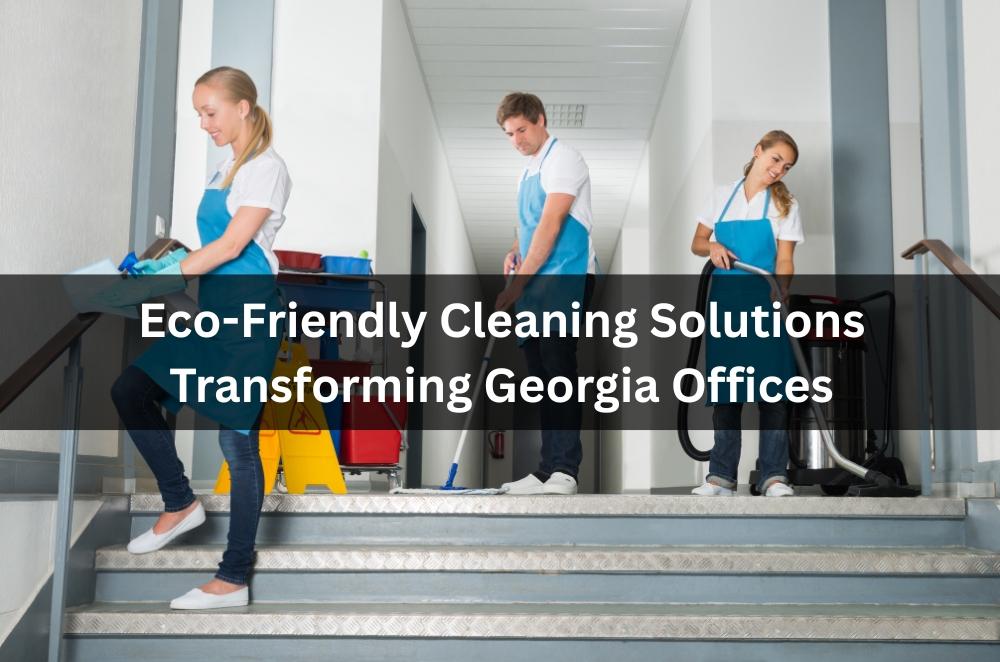Eco-Friendly Cleaning Solutions Transforming Georgia Offices

When workplaces talk sustainability, cleaning is often the quiet lever that moves the needle—less harsh chemistry, smarter equipment, and better air for the people who spend their days inside. Many facility managers now start with green janitorial programs to standardize safer products, recycling-friendly workflows, and measurable results across multi-site portfolios. Done well, these programs add up: fewer staff complaints about odors, better slip resistance on hard floors, and clearer reporting that stands up during vendor reviews and audits.
What “green” actually means in a commercial context
Sustainability isn’t a logo on a spray bottle; it’s a system of choices that protect people and the building over time. Start with practical definitions, then build policies that crews can follow on the busiest days.
-
Product criteria: Use third-party verified concentrates: Cut transport emissions and ensure consistent dilutions.
-
Dilution control: Install proportioning systems: Reduce overuse, protect surfaces, and keep costs predictable.
-
Microfiber standards: Switch from disposable wipes: Capture fine dust and reduce landfill without sacrificing hygiene.
-
Waste pathways: Separate streams at source: Make recycling the default, not the exception, at every station.
A green approach should feel ordinary, not heroic. If the system works only when the floor is quiet, it won’t last through real-world peaks.
Safety, training, and compliance that hold under pressure
Safer chemistry still needs disciplined training and documentation. Tie procedures to recognized benchmarks so expectations stay clear as teams change and sites scale.
-
Hazard briefings: Provide toolbox talks on labels: Ensure every tech can read pictograms and knows the first steps in spills.
-
PPE consistency: Standardize gloves and eye protection: Keep kits stocked on carts, not locked in distant storerooms.
-
Equipment upkeep: Log vacuum and autoscrubber servicing: Quiet motors and sealed filters protect indoor air.
-
Audit cadence: Schedule compliance walk-throughs: Catch drift early and tidy records before inspections.
For a baseline on safe methods and responsibilities, align with OSHA cleaning industry standards so the safety playbook is steady across shifts and suppliers. Clear rules reduce incidents and help new staff hit the mark faster.
From homes to offices: lessons that scale smoothly
Residential playbooks can inform commercial sites, especially around trust, communication, and consistent presentation. The same reliability that impresses a family translates well to a lobby at 8:30 am.
-
Expectation setting: Borrow welcome checklists: Tell clients what “good” will look like after a visit.
-
Arrival etiquette: Keep uniforms and carts tidy: Optics matter in foyers and shared kitchens.
-
Room order: Reset to a standard layout: Desks, chairs, and bins go back where people expect them.
-
Feedback loops: Encourage quick notes from occupants: Small fixes today prevent big complaints tomorrow.
For a feel of dependable service basics, trusted home cleaning in Georgia shows how clarity and routine build confidence—principles that scale directly into office environments with more stakeholders.
Data, transparency, and proving the impact
Sustainability is easier to defend when numbers do the talking. Simple dashboards keep everyone honest about progress and help vendors compete on outcomes, not promises.
-
Chemical spend: Track concentrates per square metre: Spot overuse fast and tune dilution controls.
-
Water draw: Log refill frequency on scrubbers: Identify zones where low-moisture methods could replace old habits.
-
Energy use: Monitor battery cycles: Align charging with off-peak and maximize runtime per shift.
-
Issue heatmaps: Visualize repeat trouble spots: Fix root causes rather than re-cleaning the same corners.
When reports travel with photos and brief notes, non-technical stakeholders still understand what’s improving—and why it matters to the bottom line.
Rolling out multi-site programs with minimal friction
The hardest part isn’t the idea; it’s making it work in ten buildings with ten different quirks. Keep the rollout boring, repeatable, and resilient to staff changes.
-
Starter kit: Standardize carts and bottles: One setup means faster training and fewer mistakes.
-
Pilot first: Test in a mid-complexity site: Use lessons to refine checklists before wider launch.
-
Train-the-trainer: Build internal champions: Site leads, coach new hires, and protect culture.
-
SLA alignment: Embed green KPIs in contracts: Make outcomes visible and connected to renewals.
Smooth rollouts tend to survive high season and staff turnover. The program becomes the default—because it’s easier, not harder, to run.
Budget sense: sustainable doesn’t mean spend more
Cost often decides whether a green plan survives the quarter. Focus on lifetime value and error-proofing to keep finance onside.
-
Concentrate math: Pay for potency, not water: Fewer deliveries, smaller storerooms, steadier costs.
-
Rework avoidance: Prevent strip-and-recoat cycles: Protect finishes with the right pads and pH.
-
Inventory control: Lock dilution and labelling: Waste drops when anyone can make a correct bottle.
-
Service rhythm: Align visit frequency with use: Target hotspots daily and low-traffic zones less often.
When the regimen finishes and reduces re-cleans, total spend stabilizes. Finance teams like systems that defend assets while keeping invoices predictable.
Closing the loop with contracts and accountability
Sustainable outcomes stick when they’re tied to clear obligations. Contracts should balance flexibility with non-negotiables that protect people and place.
-
Green KPIs: Build measurable targets: VOC thresholds, HEPA use, and water-per-square-metre baselines.
-
Verification rights: Reserve audits and product swaps: Keep spec drift from eroding performance.
-
Change control: Document substitutions: New pads or products need sign-off with test notes.
-
Exit criteria: Define handover standards: The site should be easy for the next team to maintain.
For a view on how strategy and service blend in the state context, Georgia business cleaning contracts highlight the value of aligning pricing to outcomes and building in review points so both sides keep improving.
The practical wrap-up (how to start, and why it sticks)
Switching to eco-friendly cleaning isn’t about swapping one bottle for another; it’s about designing a routine that protects people, floors, and budgets. Begin with a modest pilot in a representative building and choose concentrations with credible verification. Install dilution control so every bottle is consistent, and match machines to zones to cut water and noise. Standardize microfibre and pad choices to protect finishes while keeping a professional look in lobbies and lifts. Then make the system visible: dashboards for chemical use, water draw, and indoor air markers tell a steady story to operations, finance, and HR. Train the playbook into muscle memory with short toolbox talks and “train-the-trainer” leads so standards survive staff changes. As the pilot settles, formalize the wins in service agreements with clear KPIs and audit rights. Over a quarter or two, complaints fade, the air feels fresher, and surface life extends—while spend stops spiking from rework. The green option becomes the obvious option because it is simpler to run, easier to defend, and kinder to the people who work there every day.








